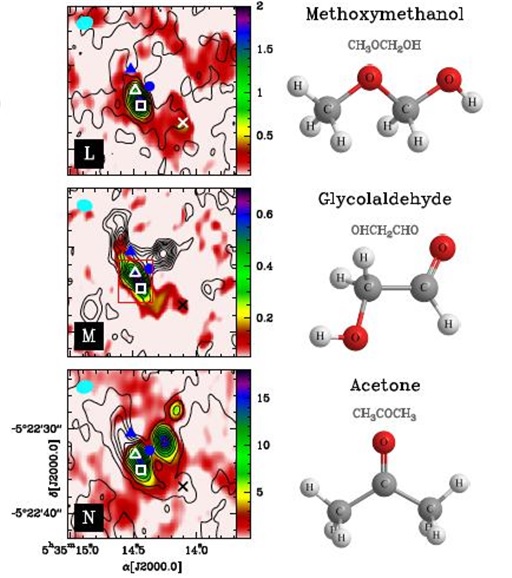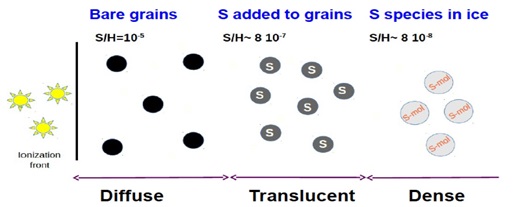Observatorio Astronómico Nacional
Infraestructura científica con más de 200 años

Astroquímica
Astroquímica es la ciencia interdisciplinar que tiene por objetivo entender los procesos físicos y químicos que determinan la composición química de gas y las partículas de polvo interestelar. La composición química del gas depende de la densidad, temperatura, grado de ionización y la radiación presente en su entorno. Cuando comprendemos bien la química asociada a una molécula, esta especie puede utilizarse como un indicador de las condiciones físicas locales. Los astrónomos usamos las moléculas como herramienta para el estudio del Universo a todas las escalas desde una galaxia externa hasta una atmósfera planetaria.
Los procesos químicos que se producen en el gas interestelar regulan la formación de estrellas y planetas. Las grandes nubes moleculares del espacio interestelar pueden fragmentarse en condensaciones más pequeñas debido, en gran parte, a que las moléculas enfrían el gas produciendo una disminución de la presión térmica. Por otra parte, las abundancia de algunos elementos como el Carbono y el azufre (S) determinan el acoplamiento del gas con el campo magnético, proceso que podría frenar, o al menos ralentizar, la contracción de la nube. El ritmo de formación de condensaciones y su posterior colapso para formar estrellas está por tanto ligado a la composición química del gas.
El conocimiento de la composición química del gas y las partículas de polvo es interesante por sí mismo. Las partículas de polvo son la materia prima a partir del cual se forman los planetas. Aunque la detección directa de los compuestos que forman una partícula de polvo es muy difícil, se han desarrollado complejos modelos químicos que incluyen la fase gaseosa y la sólida (partículas de polvo) que combinados con observaciones astronómicas son capaces de predecir la composición química del polvo. Sabemos que en el interior más profundo de las nubes moleculares las partículas de polvo se cubren de una capa de hielo rico en agua y monóxido de carbono en el que se forman moléculas orgánicas complejas. Estas especies podrían sobrevivir hasta formar parte de los embriones de planetas. Conocer el destino de algunas de estas moléculas es de gran interés para los astrónomos por su conexión con el origen de la vida.
La Astroquímica en el Observatorio Astronómico Nacional está principalmente dedicada al estudio de las nubes moleculares a partir de las cuales se forman las estrellas y los planetas. La última generación de grandes telescopios milimétricos y submilimétricos (40m Yebes telescope, Pico Veleta, NOEMA, ALMA) nos permite seguir la química del material interestelar desde las nubes moleculares hasta los discos protoplanetarios a partir del los cuales se formarán los planetas.


